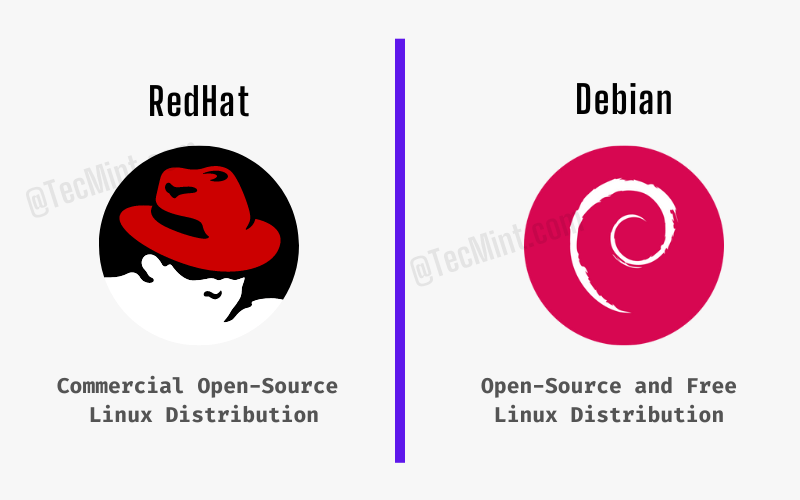
RedHat vs Debian – Software Licensing
Posted on 05/12/2023 8:11:22 AM PDT by ShadowAce
There are countless Linux distributions available, a vast majority are free to download and use. Some are more appropriate for performing particular tasks than others.
For example, Ubuntu, Mint, and Elementary OS are more recommended in desktop and laptop PCs than Arch Linux or Alpine.
In this guide, we seek to compare RHEL and Debian from an administrative point of view. We will look at the technical and philosophical differences between the two and see which fairs better than the other.
RHEL is an open-source and commercial Linux distribution developed by Red Hat, Inc which was acquired by IBM on May 3rd, 2019. It is licensed under the GNU General Public License (GPL).
Being a commercial distribution, RHEL requires a subscription. A subscription allows customers to download and install tested and certified software from Red Hat.
In addition, it provides access to 24/7 enterprise-level support. Also included in the subscription are software patches, bug fixes, software updates, and upgrades.
For more information, check out the Red Hat Subscription model.
An exception to this rule is the Red Hat Developer Program, which is a free and no-cost offering of the Red Hat Developer program that includes access to Red Hat Enterprise Linux among other Red Hat products.
This is a single subscription tailored for individual developers and may be used by developers for testing, prototyping, and small-scale production uses. It allows users to install and run RHEL on a maximum of 16 nodes: virtual or physical irrespective of system specifications and size.
On the other hand, Debian is a free and open-source Linux distribution under the GNU General Public License (GPL). It is made of free, open-source software and promises to remain 100% free. You don’t require any subscription to run Debian whether for personal or enterprise use.

RedHat vs Debian – Software Licensing
In terms of providing the most number of software packages, Debian trounces RHEL by a big margin. The latest release, Debian 11 (codenamed BullsEye) ships with over 11294 new packages, which makes a total of over 59000 software packages in its repository.
This accounts for more than 80% of the number of packages in RHEL. And as outlined in the Debian Free Software Guidelines, all software packages are free and open-source. In addition, Debian Stable releases are updated roughly twice a month.
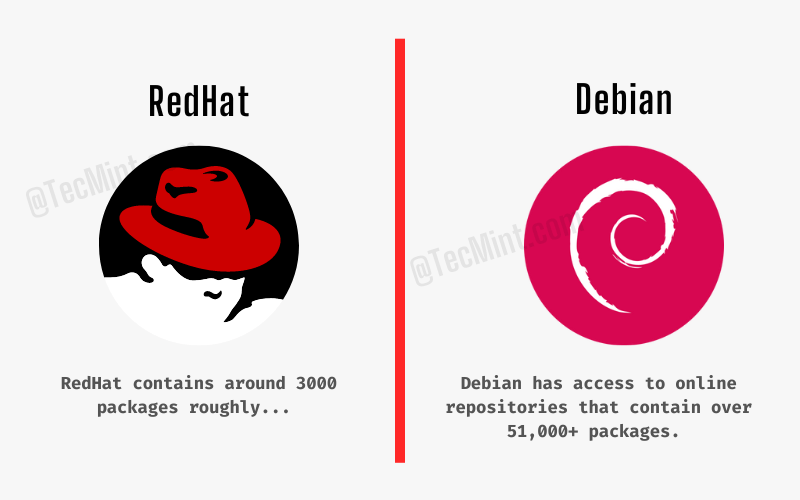
RedHat vs Debian – Number of Software Packages
Red Hat Enterprise Linux supports Power ISA, IBM Z, ARM64, and x86-64 (both server and desktop versions).
Debian is quite liberal and supports any architecture or platform that runs Linux, FreeBSD kernel, and any GNU toolsets such as GCC. As such, it supports quite a large number of systems including AMD64, i386, ARM64, PowerPC, s390(x), PPC64sparc64, and lots more.
Check out the comprehensive list of Debian-supported architectures.
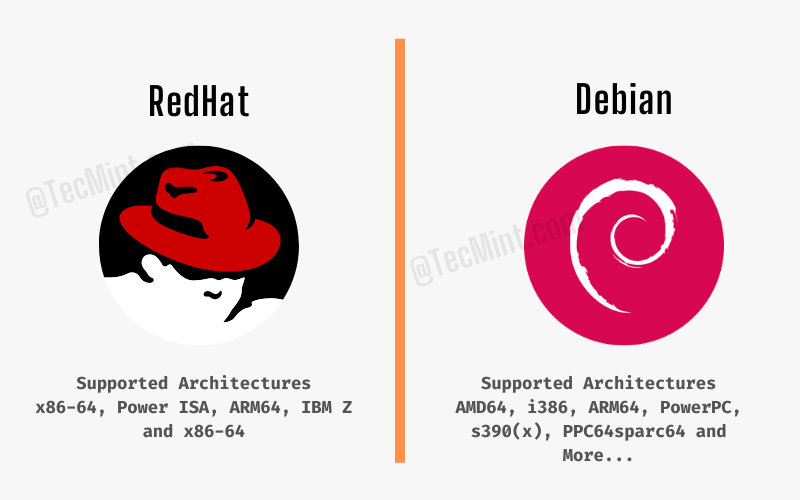
RedHat vs Debian -Supported Architectures
Both systems have excellent package managers which enable users to comfortably install and manage software packages.
From RHEL 8 and later releases, DNF is the default package manager, taking from over YUM (Yellowdog Updater Modified). This is the package manager for all RPM-based systems for which RHEL is a part.
It was initially introduced in Fedora 18 and made available in RHEL starting from RHEL 8. In addition, RHEL uses the RPM package manager to install and uninstall .rpm packages that are not contained in the official repositories.
On the other hand, Debian uses APT package manager to install and manage software packages. APT is the front-end for the dpkg tool and easily resolves dependencies.
Meanwhile, dpkg is a medium-level tool that is used to install and manage .deb packages from other external sources.
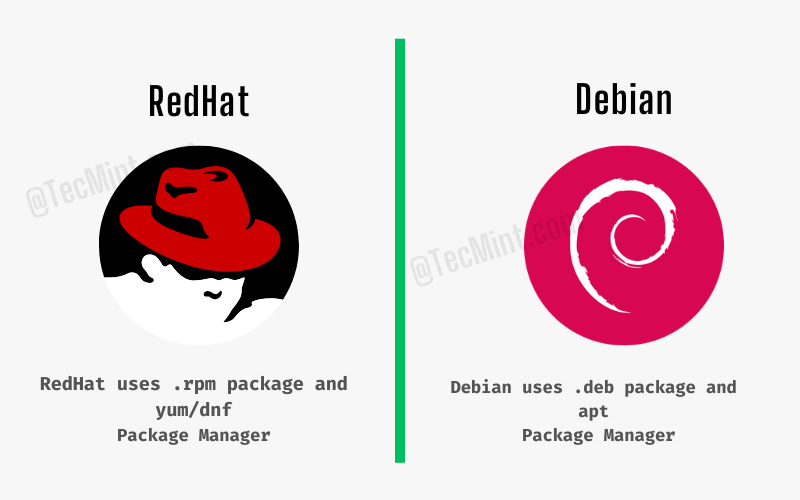
RedHat vs Debian – Software Packages
Both RHEL and Debian Stable post impressive performances. RHEL is rock solid and stable and is used in SMB (small to medium-sized) businesses and large enterprises mostly due to stellar enterprise support.
Debian comprises three branches: Unstable, Testing, and Stable. The Unstable branch provides the most recent software packages. On the flipside packages in this branch are not adequately tested and are prone to bugs and breaking, hence the moniker “Unstable”.
Packages from Unstable move to the Testing branch where more testing of software packages is done. As a result, you shouldn’t encounter as many issues as the Unstable branch.
The Testing branch ships with newer software packages and updates than the Stable release. It is used as the basis of the next Debian Stable LTS release.
Debian stable contains older versions of software packages. But these are thoroughly tested and reviewed and unlikely to cause any trouble.
Debian Stable is robust and rock solid and used in servers or environments where newer applications might cause issues with the custom software. The stable LTS releases get full support for up to 5 years.
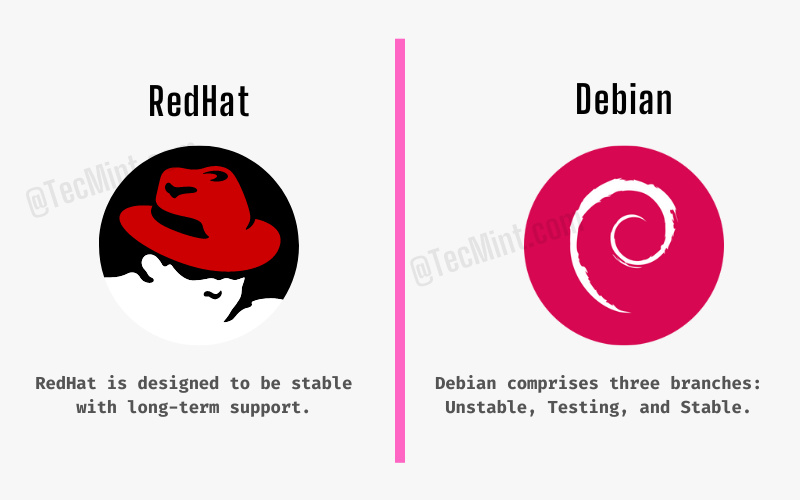
RedHat vs Debian – Stability
Security is key in any operating system especially when you are handling sensitive data.
Of the two distributions, Red Hat Enterprise provides a better security foundation. It provides built-in security and compliance requirements that help mitigate risk associated with breaches of systems and data.
It also helps automate security controls at scale with little or no downtime. You can seamlessly build, deploy, and scale applications consistently across on-premise, virtual, and cloud environments
Additionally, the security standards allow for compliance with compliance standards for organizations.
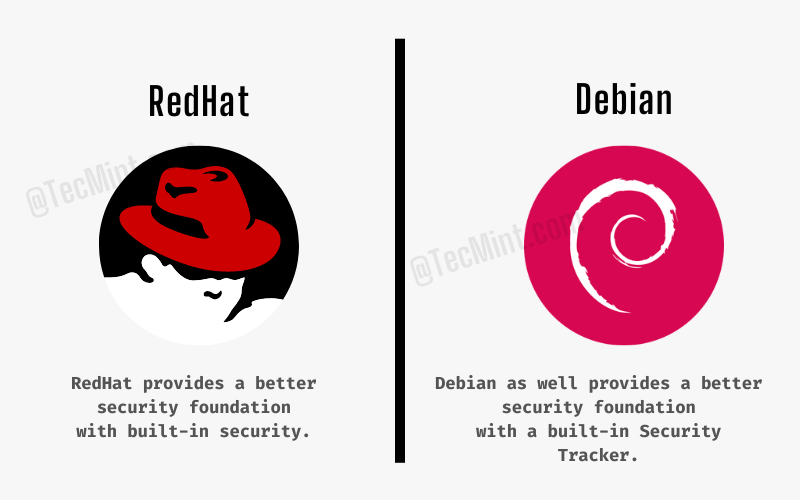
RedHat vs Debian – Security
In terms of support, Red Hat Enterprise Linux provides stellar enterprise support.
Every Red Hat subscription comes with a level of support services for specific use cases and environments. Available support levels are standard, premium, and self-support which is avaiable only in certain regions and on Red Hat Enterprise Linux Server Entry Level.
For standard and premium, you get 24/7 support for an unlimited number of cases both on the phone and over the web. Support is also based on levels of severity where Severity 1 commands the fastest initial response time of 1 hour while Severity 4 takes 8 business hours to resolve.
Debian support is community-driven and is offered by a group of volunteers. In addition, you can get help for your queries by visiting Debian User Forums which is a portal where thousands of users discuss Debian-related technical issues.
For the most part, communication between developers and users happens on mailing lists and anyone can subscribe or unsubscribe to them. You can also contact the maintainer of a package by filing a bug report. The maintainer, in turn, will receive a copy of your bug report.
As such, support in Debian may not be as timely or as accurate as the enterprise support provided by RHEL.
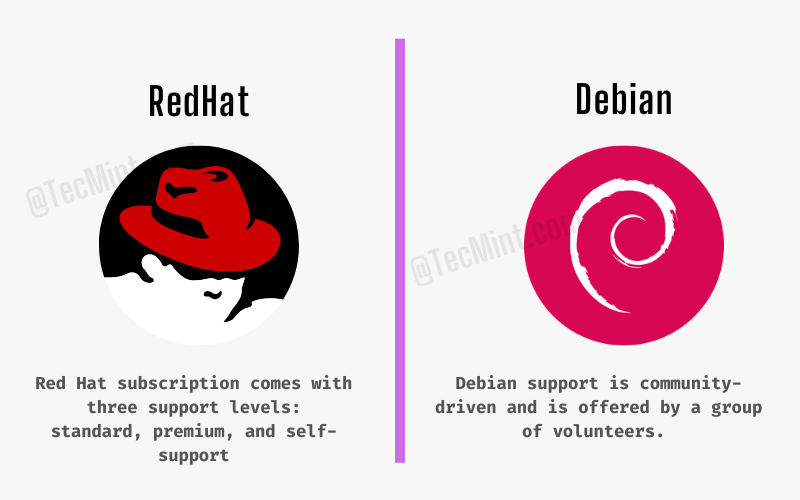
RedHat vs Debian – Technical Support
Both Red Hat Enterprise Linux and Debian are decent options for server environments. They provide excellent stability and performance for enterprise-grade applications.
However, RHEL comes out on top due to excellent enterprise support and robust security which ensures data and application security to the highest degree. It’s, therefore, a popular choice for enterprise environments which in most cases handle highly sensitive information.
Perhaps the only drawback with RHEL is its costly subscription fee which is a tall order for individuals or startups. And this is where Debian comes in.
Apart from its rock-solid stability, and high performance which is ideal for servers, it’s also totally free and open source, and so are its applications. It is a perfect choice for small companies and individuals who cannot meet the high cost of an RHEL subscription.
Could someone give reasons why an ordinary user (browser and office products) to stick with Windows and not go to Unix?
I used to use CentOS on my servers and Ubuntu on the workstations. I also had a substantial number of Windows servers running Windows Server VMs for various server roles.
Now that Fedora and many server versions of RH are free, I’d consider migrating over to them, although I was switching more to Azure with Linux-based VMs running roles since I didn’t have to worry about those losing power... Yeah, I’d switch more to RH locally.
IF I was still working.
After I retired, the dude who replaced me switched over to 100% Windows servers, because he didn’t want to learn Linux!
Very much related question —
I’m thinking of building myself a new computer and I’d like to install Linux as the base OS. If at some point I decide I need to do something in Windows, I would expect to install a Virtual Machine and install and run Windows from the VM. It just seems like the best way to distance myself from anything Windows-related.
I’m rather rusty on building and installing SW at this level. Although I think Linux first and Windows in a VM is the way to go, I wonder if I have it backwards? Anyone know?
> Could someone give reasons why an ordinary user (browser
> and office products) to stick with Windows and not go to
> Unix?
Application suites.
Windows has a plethora of office, bookkeeping, accounting, video and audio production software that is either unavailable on any Linux distribution or just plain not as good on Linux as what’s available for Windows or Mac.
And even for apps that are somewhat commensurate in performance and presentation on both Windows and Linux, the user base in Windows is considerably larger than for Linux.
However, if you’re configuring a server, Linux is DEFINITELY the way to go for many reasons, among them security. Debian is more secure than Windows, and RHEL is even more secure than Debian.
Because windoze is like the wu-flu.
Over sold, under tested and hard to cure once you catch it.
I changed years ago and never regretted it.
I bought a new Dell Inspiron a few months ago because my HP crashed. The only one immediately available had all of the hardware that I needed but was loaded with windoze.
Unbelievable to me what I went through just to log on so I could download Ubuntu.
I let the Ubuntu install wipe windoze. There is no way I would put up with that nor would I support any company that is involved in destroying our freedom, which they are actively doing.
25 years ago I retired and that was my first time since exposed to windoze. Unreal.
The real answer to your question is: Because most people are totally ignorant of what is available as an alternative.
They go in the store and every machine in the store is loaded with windoze so the easiest thing to do is hand them the credit card and go home.
“I’m thinking of building myself a new computer ...”
First thanks to the others that replied to my question.
I’m thinking of “having built” rather than “building”. I like the idea of a virtual machine running both.
I’m tangled up in a project that uses an embedded ARM processor and peripherals and haven’t got the brainpower to deal with PC issues at the same time.
Unless you’re building a server, you will want to stay with Windows 11, and I say this as a Linux guy.
The reason is that windows comes with Windows Services for Linux (WSL) which runs Linux as an app on your Windows system.
You can get the Ubuntu app for free from the Windows App store.
You will also need the free VxXsrv X Server app if you intend to launch any windows from your Linux app.
https://sourceforge.net/projects/vcxsrv/
With the VcXsrv, the Linux app runs just like a full blown Linux OS EXCEPT that there is no Linux windows manager. I launch all my linux apps from the command line, so that’s not a problem for me.
ChatGPT says you can install a Linux Windows manager, but you would need a PC capable of basically running Linux as a virtual guest.
Here is what ChatGPT says about it.
Yes, it is possible to run a Linux window manager in Windows Subsystem for Linux 2 (WSL2). However, there are a few things to keep in mind:
1. WSL2 is a command-line interface (CLI) environment. To run a window manager, you will need to install an X server on the Windows side, such as VcXsrv or X410. This will allow you to display Linux graphical applications on the Windows desktop.
2. To run a window manager, you will need to install a desktop environment on the Linux side. This can be done by installing a Linux distribution that includes a desktop environment, such as Ubuntu Desktop, or by manually installing a desktop environment like GNOME, KDE, or XFCE.
3. Running a window manager in WSL2 can be resource-intensive and may impact the performance of other applications running on your Windows system. You may need to adjust the memory and CPU allocation for the WSL2 instance to ensure smooth operation.
Once you have installed an X server on the Windows side and a desktop environment on the Linux side, you can start the X server and launch the window manager from within the Linux environment. Note that not all window managers may work well in WSL2 due to differences in the underlying system architecture and resources.
Of course, with a powerful enough system, you could just get a standard Windows 11 Pro system and install a full blown Linux distribution as a virtual guest using Virtual Box.
VirtualBox provides a seamless interface between virtual guests and the host system so that both can share the same desktop.
If you have two screens, you can put the Windows desktop on one and the Linux desktop on the other.
Could someone give reasons why an ordinary user (browser and office products) to stick with Windows and not go to Unix?
~~~
Because Libre Office sux
If you “may” use windows you are on the right track. If you will use windows, especially more frequently also maybe consider a dual-boot solution. Either way these are not permanent decisions and can be redone later if needed. Just remember to backup those files!
On this desktop I’m using Linux Mint LMDE 5 (elsie) and it’s very nice based on Debian
The only thing I miss from the Windows server world is the ease of delivering actual customer solutions with SQL Server Integration Services and Reporting Services.
Bookmarked for future reference.
I’m a Mint person and just played with LMDE 5 test/install USB and didn’t like it. It was eating resources like crazy just sitting there idling tasked with absolutely nothing. Something is running all the time using all the RAM and almost the full capacity of my processor. Just the OS... No browser no applications running. Something definitely wrong with that picture...
“If you will use windows, especially more frequently also maybe consider a dual-boot solution.”
Dual boot is a great option. Most Linux installers will create all the partitions and do it all for you in a couple clicks. They will of course make Linux the primary OS that auto boots. But if you would rather have Windows be the primary boot OS there is a simple line edit in a config file that will do that for you that changes the boot order in the boot menu.
I have a dual boot box with Linux Mint over/alongside Windows 7 and it works great. You can even access and manipulate the windows volume’s files and folders when booted in the Linux. Been working great with no problems for over six years now. And because I never use windows to access the net I don’t have any problems with it at all.
Disclaimer: Opinions posted on Free Republic are those of the individual posters and do not necessarily represent the opinion of Free Republic or its management. All materials posted herein are protected by copyright law and the exemption for fair use of copyrighted works.